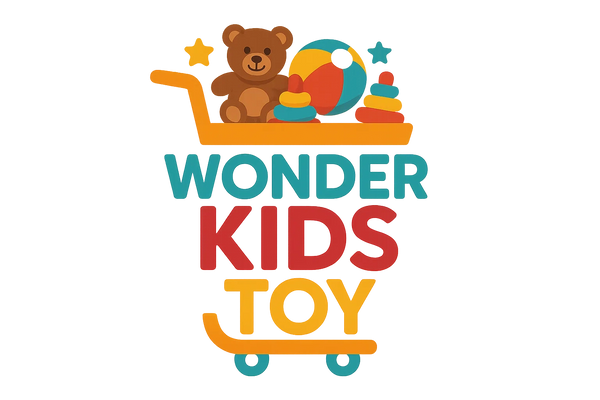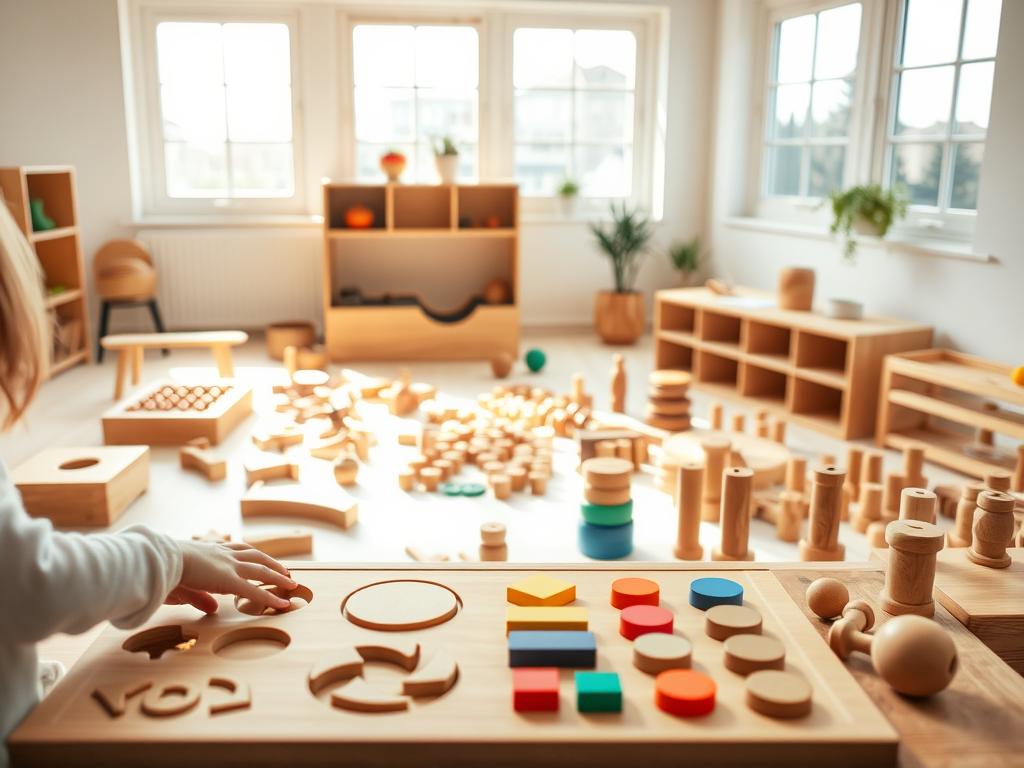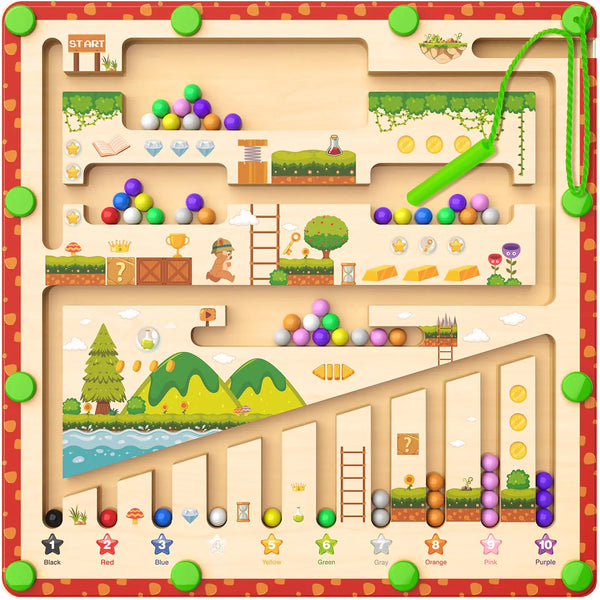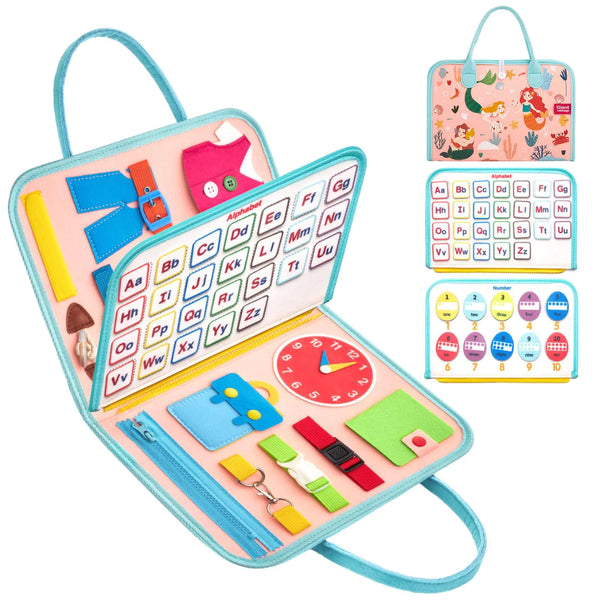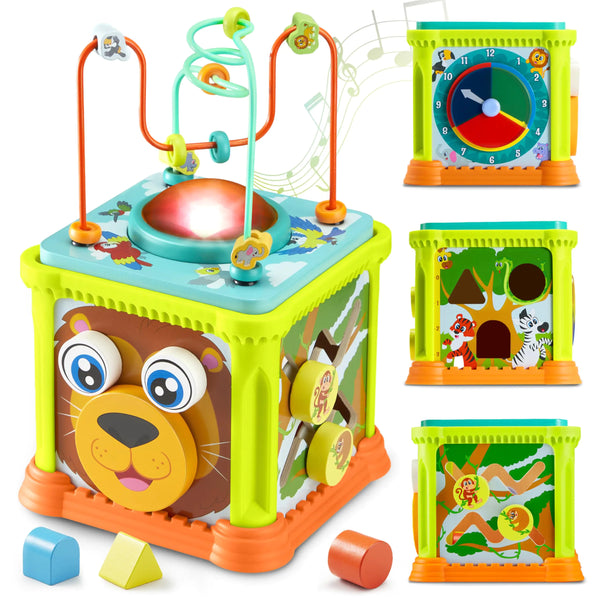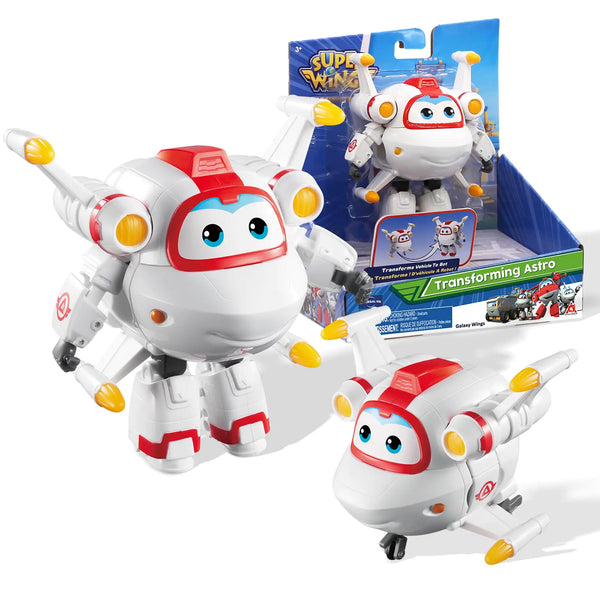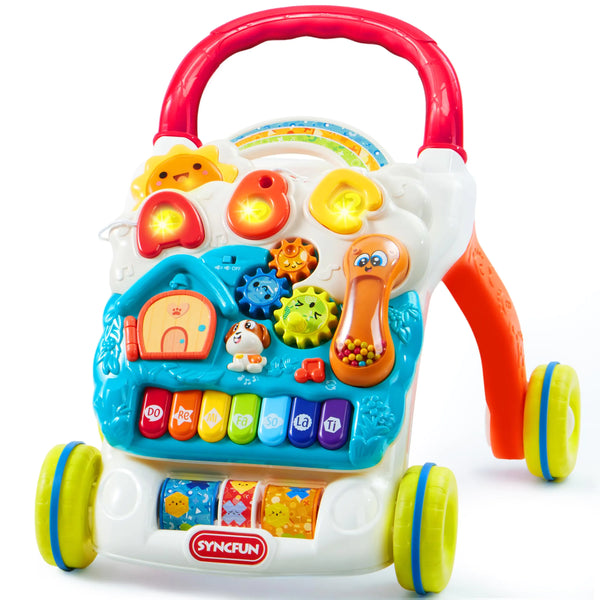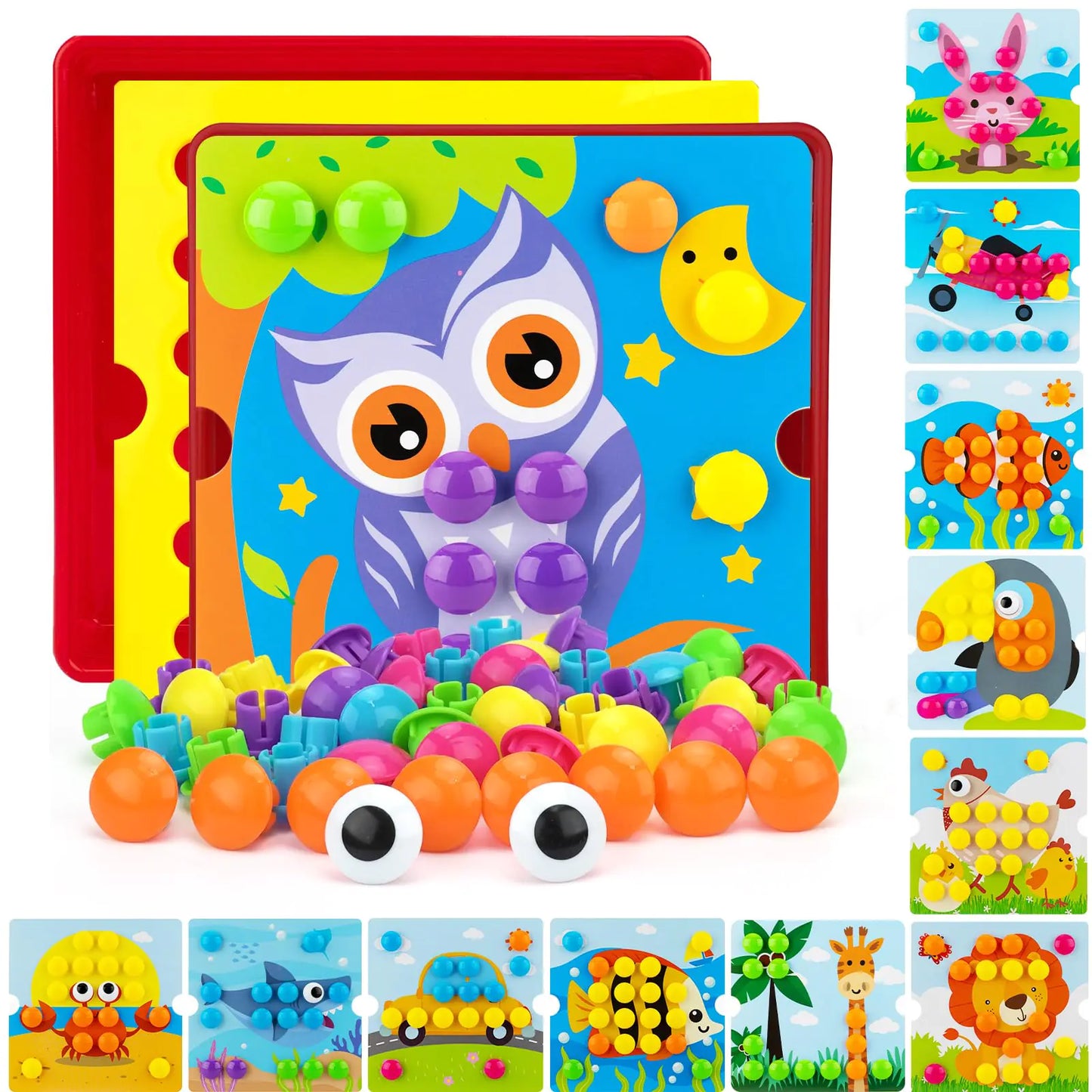As a parent, I love the Montessori method. It focuses on self-directed learning. This idea that kids can learn through special materials and activities really speaks to me.

The Montessori approach says sensory development is key for kids. With Montessori sensorial materials, they can improve their senses. They also get better at observing and staying curious.
Key Takeaways
- Montessori sensorial toys help kids learn on their own.
- These toys make kids more aware of their senses and help them grow.
- They help kids get better at observing and staying curious.
- Montessori education toys make kids focus and love learning.
- Using these toys helps parents support their child's growth.
The Montessori Approach to Sensory Development
The Montessori method focuses on sensory education. It's key for a child's growth. Kids learn best by doing things themselves.
Maria Montessori's Philosophy on Sensorial Education
Maria Montessori thought sensory experiences are key for learning. She made Montessori learning materials to help kids see and feel the world. These tools let kids focus on one sense at a time.
How Sensory Learning Shapes Brain Development
Sensory learning is vital for brain growth. Kids use sensory development tools to improve their brain. This helps them learn things like reading and math later.
- Improved thinking skills from hands-on learning
- Better movement skills from sensory play
- Kids become more independent as they learn at their own speed
Exploring Montessori Sensorial Toys and Their Purpose
Montessori sensorial toys are more than playthings. They are tools for learning and growth. These toys help kids explore and understand their world.
What Makes a Toy Truly "Montessori"
A toy is "Montessori" if it follows Maria Montessori's ideas. It should be simple, made from natural stuff, and help kids learn on their own. Montessori toys aim to teach and help kids grow smart.
The Five Senses and Corresponding Materials
Montessori toys are made to wake up each sense. They help kids learn about different textures, colors, sounds, smells, and tastes.
Visual Discrimination Materials
Color boxes are for kids to learn colors and shades. They improve how kids see things.
Tactile, Auditory, Gustatory, and Olfactory Materials
Touch toys like sandpaper and fabric teach kids about touch. Sound toys like sound cylinders help with hearing. Taste and smell toys introduce new flavors and smells. They make kids' senses wider.

The Concept of Isolation of Difficulty
Isolation of difficulty is key in Montessori learning. It means kids learn one thing at a time. This way, kids can get good at one thing before trying another.
The Benefits of Montessori Sensorial Toys for Child Development
Montessori sensorial toys help kids grow a lot. They make the world feel more real to them. Kids learn by touching, seeing, and hearing.

Cognitive and Intellectual Growth
These toys make kids smarter. They learn to sort things and understand colors and sounds. It's like a hands-on school.
- Enhances critical thinking skills
- Promotes exploration and discovery
- Develops categorization and classification skills
Fine and Gross Motor Skills Enhancement
Montessori toys also make kids better at moving. They learn to sort and pour. It's good for their hands and eyes.
"The development of fine motor skills is key for writing and dressing." - Maria Montessori
Order, Concentration, and Independence
These toys teach kids to be organized and focused. They learn to do things on their own. It's like a mini-school.
- Promotes a sense of order and organization
- Enhances concentration and attention span
- Encourages independence and self-directed learning
Preparation for Academic Learning
These toys get kids ready for school. They learn about shapes and patterns. It's like a sneak peek at school.
Social and Emotional Development
Montessori toys also help kids feel and understand emotions. They learn to share and make friends. It's like a social club.
Montessori toys are very good for kids. They help kids grow in many ways. Parents can help their kids by using these toys.
Essential Montessori Sensorial Toys for Different Ages
The Montessori method is all about the right toys for kids at each age. As kids grow, so do their needs for toys that challenge and help their senses.
Sensorial Materials for Infants (0-12 months)
Infants need toys that are simple and fun to look at and touch. Mobiles, rattles, and texture balls are perfect for them.
Mobiles, Rattles, and Texture Balls
Mobiles help babies see better. Rattles teach them to hear. Texture balls let them feel different textures. These toys are safe and fun.
Sensorial Toys for Toddlers (1-3 years)
Toddlers need toys that make their senses even sharper. Knobbed cylinders, sound boxes, and color tablets are great for this age.
Knobbed Cylinders, Sound Boxes, and Color Tablets
Knobbed cylinders improve hand-eye coordination and vision. Sound boxes help with hearing. Color tablets teach about colors.
Practical Life Materials with Sensorial Elements
Activities like pouring and sorting also help toddlers. They improve hand-eye coordination and dexterity.

Sensorial Materials for Preschoolers (3-6 years)
Preschoolers are ready for more challenging toys. Geometric solids, binomial cube, and trinomial cube are good for them.
Geometric Solids, Binomial Cube, and Trinomial Cube
Geometric solids teach about shapes. Binomial and trinomial cubes introduce math in a fun way.
Baric Tablets and Thermic Bottles
Baric tablets teach about weight. Thermic bottles help kids feel temperature differences. These toys refine their sense of touch.
Choosing the right Montessori toys for your child's age helps their senses grow. This sets a strong base for learning later on.
Creating a Montessori Sensorial Environment at Home
You can make a special place at home for your child to learn and explore. By using Montessori ideas, you can make your home a place of wonder and discovery.
Setting Up Your Space for Sensorial Exploration
Start by making your space easy to explore. Arrange things in a neat way. This lets your child move around and pick what they like.
Tips for Setting Up Your Space:
- Use low shelves to display materials within your child's reach.
- Ensure the room is well-lit and has a calm atmosphere.
- Minimize clutter to reduce distractions.
Selecting Quality Montessori Materials
Choosing the right Montessori materials is key. Look for things that are strong, look good, and focus on one sense at a time.
Key Characteristics of Montessori Materials:
- Made from natural materials like wood and fabric.
- Designed to stimulate a specific sense (e.g., texture, color, sound).
- Progress from simple to complex to challenge your child's skills.
DIY Sensorial Activities with Everyday Items
You don't need to buy expensive things to make a great sensorial space. Many things you already have can be used in fun ways.
Examples of DIY Sensorial Activities:
- Fill containers with different textures like rice, beans, or sand for a tactile experience.
- Create a sound box using empty containers and various materials like beads, pebbles, or small bells.
- Prepare a visual discrimination activity using colored cards or objects.
Guiding Without Interfering
As a parent in a Montessori setting, you guide but don't take over. Watch what your child likes and needs. Then, give them what they need without telling them what to do.
| Guiding Principles | Practical Tips |
|---|---|
| Observe and Understand | Watch your child's interests and abilities to determine the best support. |
| Prepare the Environment | Ensure the space is safe, organized, and filled with appropriate materials. |
| Offer Support | Be available to help when needed, but allow your child to take the lead. |

Conclusion: Nurturing Your Child's montessori sensorial activities Through Sensorial Education
Looking back, I see how important sensorial education is. It helps kids grow in many ways. By adding montessori sensorial activities to their day, parents help them become independent and curious.
Montessori learning materials and sensory development tools are key. They help kids learn and grow. These tools let kids focus on one thing at a time, helping them understand the world better.
Using Montessori ideas, parents can make a space for kids to explore. I suggest you learn more about Montessori sensorial education. See how it can help your child grow.
FAQ
What are Montessori sensorial toys, and how do they support my child's development?
Montessori sensorial toys are special materials for kids. They help kids learn by using their senses. This makes kids smarter and better at learning.
How do I choose the right Montessori sensorial toys for my child's age group?
Pick toys based on your child's age. For babies, try texture balls and sound toys. Toddlers like sensory bins and stacking toys. Preschoolers need color boxes and sound cylinders.
What makes a toy "Montessori," and how can I identify authentic Montessori materials?
Montessori toys help kids learn on their own. They use natural materials and focus on one skill. Look for toys that let kids learn by trying things out.
How can I create a Montessori sensorial environment at home, and what materials do I need?
Make a special area for sensory play. Use toys like texture balls and sensory bins. You can also use everyday things like rice and beans. Let your child explore without helping too much.
What are some benefits of using Montessori sensorial toys for my child's cognitive and social-emotional development?
These toys improve senses and focus. They also help kids become independent and confident. This prepares them for school.
Can I use Montessori sensorial toys with children who have special needs or sensory processing issues?
Yes, these toys can help kids with special needs. They help kids with sensory issues feel better. Talk to a therapist or Montessori teacher to find the right toys.
How do Montessori sensorial toys support my child's preparation for academic learning?
These toys build important skills like focus and fine motor. They also teach about order and comparison. This helps kids do well in school.

